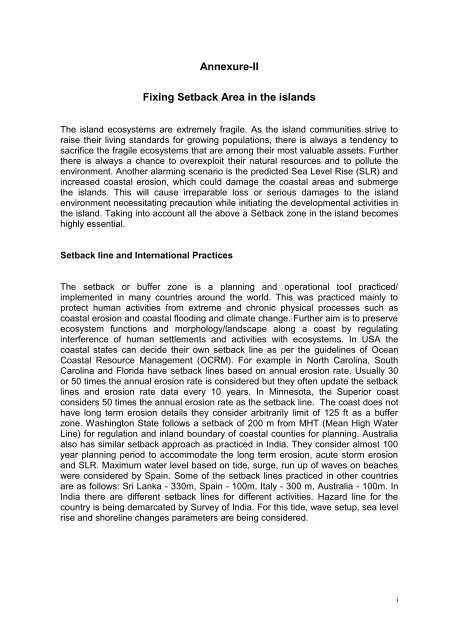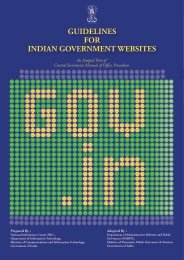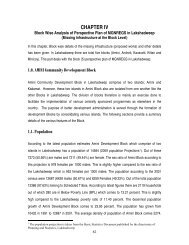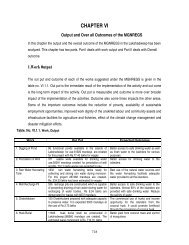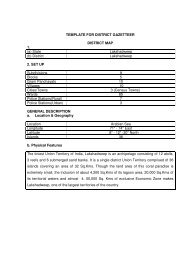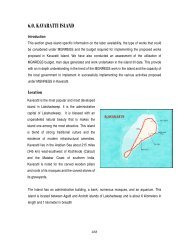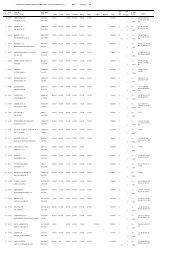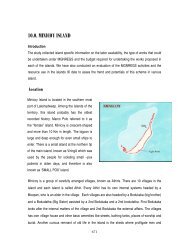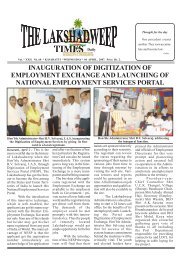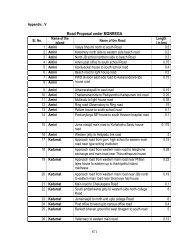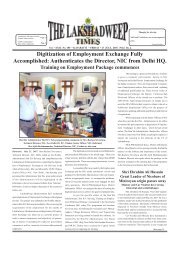Annexure_2 - Lakshadweep
Annexure_2 - Lakshadweep
Annexure_2 - Lakshadweep
Create successful ePaper yourself
Turn your PDF publications into a flip-book with our unique Google optimized e-Paper software.
<strong>Annexure</strong>-II<br />
Fixing Setback Area in the islands<br />
The island ecosystems are extremely fragile. As the island communities strive to<br />
raise their living standards for growing populations, there is always a tendency to<br />
sacrifice the fragile ecosystems that are among their most valuable assets. Further<br />
there is always a chance to overexploit their natural resources and to pollute the<br />
environment. Another alarming scenario is the predicted Sea Level Rise (SLR) and<br />
increased coastal erosion, which could damage the coastal areas and submerge<br />
the islands. This will cause irreparable loss or serious damages to the island<br />
environment necessitating precaution while initiating the developmental activities in<br />
the island. Taking into account all the above a Setback zone in the island becomes<br />
highly essential.<br />
Setback line and International Practices<br />
The setback or buffer zone is a planning and operational tool practiced/<br />
implemented in many countries around the world. This was practiced mainly to<br />
protect human activities from extreme and chronic physical processes such as<br />
coastal erosion and coastal flooding and climate change. Further aim is to preserve<br />
ecosystem functions and morphology/landscape along a coast by regulating<br />
interference of human settlements and activities with ecosystems. In USA the<br />
coastal states can decide their own setback line as per the guidelines of Ocean<br />
Coastal Resource Management (OCRM). For example in North Carolina, South<br />
Carolina and Florida have setback lines based on annual erosion rate. Usually 30<br />
or 50 times the annual erosion rate is considered but they often update the setback<br />
lines and erosion rate data every 10 years. In Minnesota, the Superior coast<br />
considers 50 times the annual erosion rate as the setback line. The coast does not<br />
have long term erosion details they consider arbitrarily limit of 125 ft as a buffer<br />
zone. Washington State follows a setback of 200 m from MHT (Mean High Water<br />
Line) for regulation and inland boundary of coastal counties for planning. Australia<br />
also has similar setback approach as practiced in India. They consider almost 100<br />
year planning period to accommodate the long term erosion, acute storm erosion<br />
and SLR. Maximum water level based on tide, surge, run up of waves on beaches<br />
were considered by Spain. Some of the setback lines practiced in other countries<br />
are as follows: Sri Lanka - 330m, Spain - 100m, Italy - 300 m, Australia - 100m. In<br />
India there are different setback lines for different activities. Hazard line for the<br />
country is being demarcated by Survey of India. For this tide, wave setup, sea level<br />
rise and shoreline changes parameters are being considered.<br />
i
Setback Zone for the island<br />
A setback is an area within the islands’ coastal zone wherein certain development<br />
activities are prohibited or significantly restricted as detailed in the <strong>Annexure</strong> II. The<br />
setbacks are a means of accomplishing a number of objectives including:<br />
<br />
<br />
<br />
Providing livelihood security to the local communities including the fisher folk<br />
and tribals.<br />
Promote conservation and protection of Island’s unique environment and its<br />
marine area<br />
To promote development through sustainable integrated management plan<br />
based on scientific principles taking into account the vulnerability of the coast<br />
to natural hazards<br />
A setback area is composed of the reservation area or reservation line lying<br />
between seaward reference line of High Tide Line (HTL) and the landward<br />
reference line of the particular coastal segment to be decided scientifically on a<br />
case to case basis along the Island’s coast. In the islands’ coast the reference line<br />
is the HTL which is generally 2 to 2.5 m above the Mean Sea Level (MSL) has been<br />
well documented.<br />
Criteria for Setback Line<br />
The IPZ Notification clearly says that the Integrated Island Management Plan ‘shall<br />
address vulnerability to human life and property based on elevation,<br />
geomorphology, sea level trends and horizontal shoreline displacement’. It further<br />
says that the IIMP may indicate suitable areas that are safe for locating dwelling<br />
units, infrastructure and also appropriate safeguards measures to protect the life<br />
and property of the local communities from natural hazards. A No Development<br />
Zone or Setback area is determined so as to achieve the above objectives as<br />
required in the IIMP for the island.<br />
The criteria for establishing the setback line for each segment of the islands’<br />
coastline has been worked out based on the hazard perception. The segments<br />
have been rated based on the hazards experienced by the islands. The major<br />
hazards considered are:<br />
<br />
<br />
<br />
<br />
<br />
Severe monsoon wave activity and wave set up (due to waves and tides)<br />
Coastal flooding (geology, geomorphology and land elevation as base<br />
parameters)<br />
Horizontal shoreline displacement (erosion / accretion)<br />
Sea level trends (Elevation)<br />
Cyclones, storm surges and tsunami<br />
ii
Though islands face many hazards the most important ones which need to be<br />
considered are high monsoonal waves and coastal flooding, shoreline<br />
displacement and sea level trends. The cyclones, storm surges and tsunami have<br />
not been considered for setback line, as they are rare events and have been<br />
accounted in the disaster management plans included in the IIMP by providing<br />
cyclone shelters, road communication, etc.<br />
(i) High monsoon waves:<br />
Waves are one of the most frequent hazards that are active in the island. It is<br />
one among the parameters that significantly contribute to shoreline changes.<br />
The impact of waves increases due to wave and wind set up. The impact is<br />
more during the high tidal conditions. The changes in the shoreline truly<br />
reflect the impact of the waves, tides and wind. Hence it is more practical to<br />
examine the long term shoreline changes to account for the above effects.<br />
(ii) Horizontal shoreline displacement:<br />
The long-term shoreline changes are considered as an important parameter<br />
to determine the setback line. The shoreline erosion / accretion phenomenon<br />
along the island’s coast is not continuous but the coast which has been<br />
traditionally eroding may be accreting after a few a years. This can happen<br />
due to anthropogenic factors as well like the construction of coastal<br />
structures, development of harbour, foreshore based activities, etc. The<br />
long-term shoreline changes for a period of 32 years were computed<br />
for this purpose<br />
(iii) Sea level trends<br />
It is now well known that the sea levels are increasing in most part of the<br />
world due to the global warming phenomenon. Though local studies specific<br />
to the islands are not available the Intergovernmental Panel for Climate<br />
Change (IPCC) has given a projection of 45 cm of sea level rise globally as a<br />
moderate scenario for the period 2000-2100. To be on the conservative side<br />
this projection is adopted for the island and a rise of 50 cm is accounted for<br />
the purpose of the setback line. This means a coastal zone falling within this<br />
rise is vulnerable to the impact of the sea level rise projected. It is to be<br />
remembered that the impacts of the day to day waves and tides are also<br />
accommodated within this elevation. Hence the area falling within this<br />
elevation can be taken as the setback zone. Since the present day impacts<br />
are felt up to the HTL and the projections are intented for the future, the<br />
elevations are taken above the HTL.<br />
From the above discussion the two measurable criteria for determining the set back<br />
line in the islands are horizontal shoreline displacement (erosion and accretion) and<br />
elevation. Since the shoreline erosion / accretion is a dynamic process wherein the<br />
coast which has been traditionally eroding may turn to an accreting coast and vice<br />
versa after a few years of time due to many factors including anthropogenic like<br />
construction of coastal structures, development of harbor and port, foreshore based<br />
iii
activities, etc. Hence the shoreline changes independently may not give the correct<br />
measurable criteria for identifying the setback line. The other parameter is the<br />
elevation of the island with respect to HTL. Considering all the above a distance<br />
upto the elevation of 0.5 m above HTL is taken as a general parameter for fixing<br />
the setback line.<br />
For fixing the distance to the 0.5m elevation from the HTL the island is divided into<br />
several segments and the parameters were determined scientifically for each.<br />
Though there is no considerable variation in the segments examined, as a<br />
conservative measure the maximum value for the block of segments is taken as the<br />
setback distance for that portion of the island.<br />
It has been noted that some part of the island is thickly populated and highly<br />
developed. To cater to the greater demands of coastal area in the developed zones<br />
it may not always be acceptable if a uniform setback is provided for the entire<br />
island. Taking clue from the criteria adopted in categorizing the coastal zone as<br />
CRZ-II and CRZ-III and allowing more development in CRZ-II in the original CRZ<br />
Notification, the setback in the island is determined based on the criteria whether<br />
the portions of the island are developed or undeveloped, availability of free space<br />
and differential exposure to natural hazards. Based on the scientific approach as<br />
outlined in the <strong>Annexure</strong> a moderate setback distance is considered for the<br />
developed area. For the portion which has sparse settlement or is undeveloped<br />
with more open space the maximum observed setback distance is provided as a<br />
conservative measure.<br />
iv


